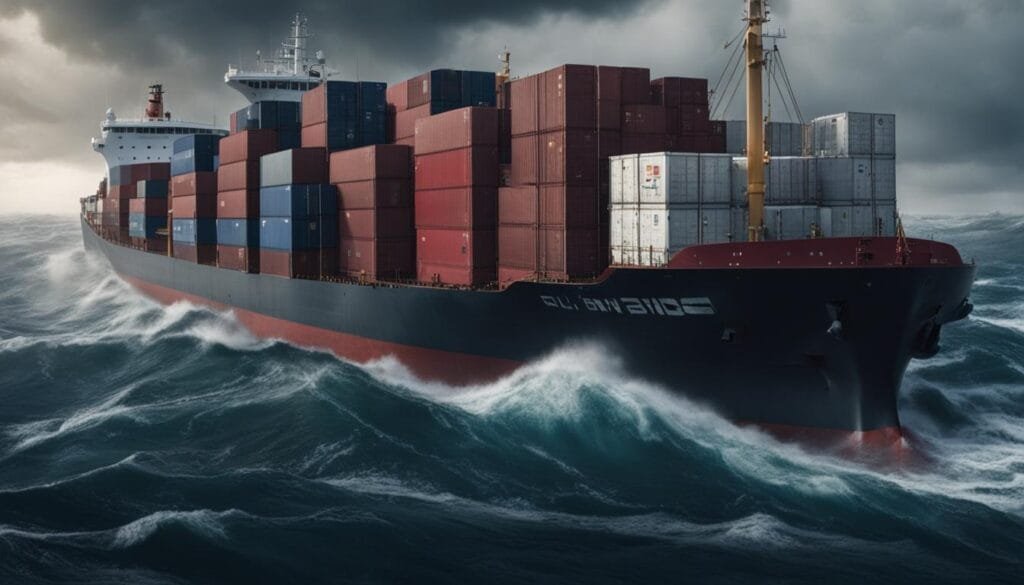The global financial system has faced significant challenges in recent years, including higher inflation, geopolitical risks, and tighter financial conditions. These factors have tested the resilience of the system and highlighted the importance of building financial stability. In this article, we will explore ways to strengthen global financial stability and the key economic challenges and solutions essential to ensuring a resilient global economy.
Key Takeaways:
- Global Financial Stability is crucial for economic steadiness and security
- Building a strong financial foundation ensures long-term economic assurance
- Financial constancy and global balance are essential for economic strength
- Assessing and measuring financial stability is key to identifying risks and vulnerabilities
- Challenges such as inflation and geopolitical risks require proactive measures to maintain stability
The Importance of Financial Stability
Financial stability is crucial for a robust and healthy global economy. It refers to the absence of system-wide episodes in which the financial system fails to function effectively, as well as the resilience of financial systems to stress. A stable financial system efficiently allocates resources, assesses and manages financial risks, and maintains employment levels. It also plays a vital role in preventing banking crises, hyperinflation, and stock market crashes. Without financial stability, banks may be reluctant to finance profitable projects, asset prices may deviate excessively, and payments may be delayed. Therefore, ensuring and strengthening global financial stability is essential for sustainable economic growth.
“A stable financial system is the foundation for a strong and thriving global economy. It provides the stability and confidence needed for businesses and individuals to make long-term investment decisions, driving economic growth and development. Financial stability is not just about individual institutions, but about the overall health and resilience of the entire financial system. It requires sound regulation, effective risk management, and proactive measures to identify and address potential vulnerabilities. By prioritizing financial stability, we can create a secure and predictable environment for economic activity.”
Financial stability is closely intertwined with the global economy. During times of uncertainty and volatility, a stable financial system helps cushion the impact and prevent widespread disruptions. It ensures the efficient flow of funds, promotes investment, and fosters economic stability. Additionally, financial stability enhances economic security by reducing the likelihood of financial crises and their associated negative consequences. By maintaining a solid financial foundation, countries can weather economic shocks more effectively and sustain long-term economic growth.
Assessing Financial Stability
Measuring financial stability is a crucial step in understanding and ensuring the resilience of the global financial system. It requires a comprehensive assessment of both individual institutions and the overall system. Various measures and indicators are used to evaluate stability at different levels.
Firm-level Stability Measures
At the firm level, one commonly used measure is the z-score. This measure compares a bank’s capitalization and returns to the volatility of its returns, providing an assessment of its solvency risk. The higher the z-score, the more stable the institution is considered to be. Other measures, such as the Merton model and the Distance to Default, calculate the probability of credit default for firms.
Systemic Stability Measures
Systemic stability measures aim to aggregate firm-level measures into a system-wide evaluation, taking into account the interconnectedness of financial institutions. These measures provide insights into the stability and potential risks of the entire financial system. Examples of systemic stability measures include the First-to-Default probability and the Systemic Expected Shortfall.
By combining firm-level and systemic stability measures, policymakers and regulators can gain a comprehensive understanding of the overall health and stability of the financial system. These assessments help identify vulnerabilities, monitor risks, and inform appropriate policy interventions to ensure the stability of the global economy.

Table: Financial Stability Measures
| Measure | Description |
|---|---|
| Z-score | Compares buffers (capitalization and returns) with risk (volatility of returns) to assess solvency risk at the firm level. |
| Merton model | Calculates the probability of credit default for firms. |
| Distance to Default | Estimates the distance between a firm’s value and its default point. |
| First-to-Default probability | Measures the likelihood that a financial institution will experience distress or default. |
| Systemic Expected Shortfall | Predicts the potential losses of the entire financial system in a crisis scenario. |
Challenges to Global Financial Stability
Global financial stability faces several significant challenges that have the potential to disrupt economic stability and undermine the resilience of the global financial system. These challenges include:
- Financial Stability Risks: The interconnected nature of the global financial system exposes it to various risks that can have far-reaching consequences. Market volatility, liquidity shortages, and excessive leverage are just a few examples of the risks that can threaten financial stability.
- Inflation: Rising inflation levels can pose a challenge to financial stability. Inflation erodes the purchasing power of individuals and reduces the value of financial assets, leading to increased uncertainty and potential economic disruptions.
- Geopolitical Risks: Geopolitical tensions and conflicts can have a profound impact on financial stability. Political instability, trade disputes, and economic sanctions can disrupt global markets, increase market volatility, and hinder cross-border transactions.
- Nonbank Financial Intermediaries: The rise of nonbank financial intermediaries, such as hedge funds and shadow banks, presents a potential risk to financial stability. These entities operate outside the traditional banking sector and often have less regulation and oversight, making them susceptible to systemic risks.
Addressing these challenges requires a proactive and coordinated approach by policymakers, regulators, and financial institutions. Close monitoring of financial stability indicators, implementing appropriate risk management measures, and enhancing oversight of nonbank financial intermediaries are essential steps toward ensuring a stable and resilient global financial system.

Risks and Implications
The challenges to global financial stability have far-reaching implications. They can disrupt economic growth, increase market volatility, and jeopardize the stability of financial institutions. For example, high inflation can lead to increased borrowing costs, reduced investment, and decreased consumer spending, all of which can dampen economic activity.
Geopolitical risks can create uncertainty and hinder international trade and investment. They can also result in currency fluctuations, capital outflows, and other disruptions that affect financial markets. Similarly, the vulnerabilities associated with nonbank financial intermediaries can amplify systemic risks and contribute to financial market instability.
It is essential to address these challenges through effective risk mitigation strategies, improved regulatory frameworks, and enhanced international cooperation. By doing so, we can foster a more stable and resilient global financial system that can withstand economic shocks and support sustainable economic growth.
Strengthening Financial Stability
Ensuring and strengthening global financial stability is a critical task that requires the implementation of various measures. Central banks play a crucial role in this endeavor through their policies and financial oversight. They have the responsibility of striking a balance between addressing financial stability risks and achieving price stability objectives, especially in environments characterized by high inflation and tighter financial conditions.
In addition to central bank policies, enhancing financial oversight is essential to promote stability. By closely monitoring financial institutions, regulators can identify and address potential risks before they escalate. Robust oversight mechanisms help to maintain the integrity and soundness of the financial system, protecting it from vulnerabilities that could disrupt stability.
Furthermore, strengthening international cooperation is paramount in the pursuit of financial stability. Geopolitical tensions and global interconnectedness necessitate collaborative efforts among nations to address financial fragmentation, capital flow reversals, and cross-border payment disruptions. Through coordinated actions, countries can mitigate the negative consequences of geopolitical risks and foster stability in the global financial system.
The Impact of Geopolitics on Financial Stability
Geopolitical risks have become increasingly prominent in recent years and have significant implications for global financial stability. These risks can lead to financial fragmentation, disrupting the cross-border allocation of capital and impacting international payment systems. As a result, banks may experience higher funding costs, reduced profitability, and limited credit provision to the private sector. The transmission of geopolitical shocks to financial institutions needs to be carefully assessed, and policymakers must ensure that adequate capital and liquidity buffers are in place to mitigate these risks.
“Geopolitical tensions can create macro-financial volatility and hinder international risk diversification,” says Dr. Jane Smith, an expert in global finance. “It’s crucial for policymakers to monitor and manage these risks effectively to safeguard financial stability and promote sustainable economic growth.”
The Table below highlights the impact of geopolitical risks on financial stability:
| Impact | Explanation |
|---|---|
| Financial Fragmentation | Geopolitical tensions can lead to the fragmentation of global financial markets, impairing the efficient flow of capital across borders. |
| Capital Flow Reversals | Rising geopolitical risks can trigger sudden capital outflows from affected regions, leading to significant disruptions and volatility in financial markets. |
| Funding Costs | Heightened geopolitical tensions can increase borrowing costs for financial institutions, impacting their profitability and ability to provide credit to businesses and individuals. |
| Credit Provision | Geopolitical risks can create a cautious lending environment, with banks and other financial intermediaries becoming more risk-averse, resulting in limited credit availability. |
Addressing the impact of geopolitical risks on financial stability requires a coordinated and proactive approach from policymakers, central banks, and international organizations. Enhancing risk monitoring systems, fostering international cooperation, and implementing robust contingency plans are essential to mitigate the potential adverse effects of geopolitical tensions and maintain the stability of the global financial system.

Conclusion
Building and maintaining global financial stability is crucial for ensuring a resilient and strong global economy. Despite the challenges posed by higher inflation, geopolitical risks, and vulnerabilities in the financial system, proactive measures can be taken to enhance financial stability and foster a prosperous future.
Strengthening financial oversight and implementing appropriate policy interventions are essential steps in ensuring the stability and sustainability of the global financial system. By closely monitoring and addressing risks, financial authorities can mitigate potential disruptions and promote a resilient environment for economic growth.
Fostering international cooperation is also vital in tackling financial fragmentation, capital flow reversals, and disruptions to cross-border payments fueled by geopolitical tensions. Through enhanced coordination and collaboration, countries can collectively address these challenges and build a solid foundation for global economic security.
By continually evaluating and implementing necessary measures, the global community can strengthen global financial stability, facilitating a resilient global economy that can weather future uncertainties and thrive in the face of adversity.
FAQ
What is financial stability?
Financial stability refers to the absence of system-wide episodes where the financial system fails to function effectively. It also includes the resilience of financial systems to stress and their ability to efficiently allocate resources, assess and manage financial risks, and maintain employment levels. Financial stability is crucial for sustainable economic growth.
How is financial stability measured?
Financial stability can be measured at both the individual institution and overall system levels. At the firm level, measures like the z-score, Merton model, and Distance to Default are used to assess solvency risk and the probability of credit default. Systemic stability measures, such as the First-to-Default probability and Systemic Expected Shortfall, aggregate firm-level measures to evaluate the stability and risks of the entire financial system.
What are the challenges to global financial stability?
Global financial stability faces challenges such as higher inflation, geopolitical risks, and vulnerabilities in nonbank financial intermediaries (NBFIs). These challenges have been amplified by tighter monetary and financial conditions, as well as the buildup of vulnerabilities since the global financial crisis. Addressing these challenges requires careful monitoring, policy interventions, and enhanced oversight of NBFIs.
How can global financial stability be strengthened?
Policymakers can strengthen global financial stability by implementing measures such as central bank policies, financial oversight, and international cooperation. Central banks play a crucial role in balancing financial stability risks with price stability objectives. Strengthening international cooperation is vital to address financial fragmentation, capital flow reversals, and disruptions to cross-border payments caused by geopolitical tensions. Building larger buffers, enhancing financial oversight, and improving international coordination are key steps towards a stable and resilient global financial system.
What impact does geopolitics have on financial stability?
Geopolitical tensions can significantly affect financial stability. They can lead to financial fragmentation, impacting the cross-border allocation of capital, international payment systems, and asset prices. This can increase banks’ funding costs, reduce profitability, and limit credit provision to the private sector. Geopolitical risks also hinder international risk diversification and can create macro-financial volatility. Policymakers need to consider and mitigate the risks associated with rising geopolitical tensions and ensure sufficient capital and liquidity buffers in light of these risks.
Why is global financial stability important for the global economy?
Building and maintaining global financial stability is vital for a resilient and strong global economy. It ensures efficient resource allocation, risk management, and employment levels. Financial stability prevents banking crises, hyperinflation, and stock market crashes. Without financial stability, banks may be reluctant to finance profitable projects, asset prices may deviate excessively, and payments may be delayed. By addressing challenges and implementing necessary measures, we can build a solid foundation for global economic security and prosperity.
What Are Some Strategies for Building Financial Stability in a Global Economy?
There are several strategies for building financial stability in a global economy. Diversifying investments across various markets can help minimize risks and maximize potential returns. Implementing sound risk management practices, such as setting up emergency funds, can provide a safety net during economic downturns. Additionally, seeking opportunities for international trade and partnerships can help create a stable revenue stream. Overall, building financial stability in a global economy requires a strategic and proactive approach.
What Strategies Can I Use to Survive and Thrive in a Global Financial Crisis?
When faced with surviving global financial crises, it is crucial to adopt strategic measures for both survival and growth. Diversifying investments, reducing expenses, and exploring new market opportunities are key strategies to navigate through challenging times. Additionally, strengthening financial literacy, maintaining a healthy emergency fund, and seeking professional advice can help individuals and businesses thrive amidst a global financial crisis.

